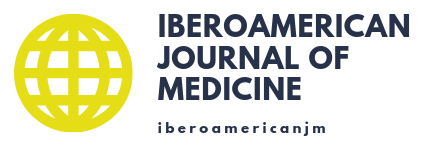Posterior midline cleft of the atlas – a crucial anatomical variation in vertebral fractures
Hendidura posterior de la línea media del atlas - una variación anatómica crucial en las fracturas vertebrales
Serghei Covantev, Rasul Uzdenov, Kseniya Zabudskaya, Olga Belic
Abstract
The anatomy of the first vertebra, namely atlas, has significant clinical implications. Atlas is situated between the occipital bone and the second cervical vertebra (axis) and is one of the main points of head movement. Most congenital anomalies of the vertebra are diagnosed incidentally during imaging investigations and can be associated with cervical spine anomalies. The neurological symptoms may include weakness in the four limbs, acute neurologic deficits such as transient quadriparesis, paraparesis, Lhermitte's sign, chronic neck pain, and headache. This anomaly is also commonly seen in gonadal dysgenesis, Klippel-Feil syndrome, Arnold-Chiari malformations, and Turner and Down syndrome. Unlike other variations, which arise due to disturbances of ossification posterior midline clefts of the atlas, are different since they are a developmental failure of chondrogenesis. We therefore present an anatomical case and analysis of the literature about posterior arch clefts of atlas.
Keywords
Resumen
La anatomía de la primera vértebra, a saber, el atlas, tiene importantes implicaciones clínicas. Atlas está situado entre el hueso occipital y la segunda vértebra cervical (axis) y es uno de los principales puntos de movimiento de la cabeza. La mayoría de las anomalías congénitas de las vértebras se diagnostican de manera incidental durante las investigaciones por imágenes y pueden asociarse con anomalías de la columna cervical. Los síntomas neurológicos pueden incluir debilidad en las cuatro extremidades, déficits neurológicos agudos como cuadriparesia transitoria, paraparesia, signo de Lhermitte, dolor de cuello crónico y dolor de cabeza. Esta anomalía también se observa con frecuencia en la disgenesia gonadal, el síndrome de Klippel-Feil, las malformaciones de Arnold-Chiari y el síndrome de Turner y Down. A diferencia de otras variaciones, que surgen debido a alteraciones de la osificación, las hendiduras de la línea media posterior del atlas, son diferentes ya que son una falla en el desarrollo de la condrogénesis. Por tanto, presentamos un caso anatómico y un análisis de la literatura sobre las hendiduras del arco posterior del atlas.
Palabras clave
References
1. Covantev S, Mazuruc N, Belic O. Kimmerle Anomaly – An Important Anatomical Variation. Online J Health Allied Scs. 2018;17(3):8.
2. Pacheco Fernandes RM, Sarmento Pires LA, Martins Manaia JH, Cisne de Paula R, Babinski MA. Agenesis of the posterior arch of the atlas: an incidental finding in a polytraumatized patient. Coluna/Columna. 2019;18:81-3. doi: 10.1590/S1808-185120191801187278.
3. Kwon JK, Kim MS, Lee GJ. The incidence and clinical implications of congenital defects of atlantal arch. J Korean Neurosurg Soc. 2009;46(6):522-7. doi: 10.3340/jkns.2009.46.6.522.
4. Prempe RC, Gibson JC, Bhattacharya JJ. Mid-line clefts of the atlas: a diagnostic dilemma. Spinal Cord. 2002;40(2):92-3. doi: 10.1038/sj.sc.3101230.
5. Jefferson G. Fracture of the atlas vertebra. Report of four cases, and a review of those previously recorded. Br J Surg. 1919;7(27):407-22. doi: 10.1002/bjs.1800072713.
6. Currarino G, Rollins N, Diehl JT. Congenital defects of the posterior arch of the atlas: a report of seven cases including an affected mother and son. AJNR Am J Neuroradiol. 1994;15(2):249-54.
7. Geipel P. [Studies on the fissure formation of the atlas and epistropheus. IV]. Zentralbl Allg Pathol. 1955;94(1-2):19-84.
8. Schulze PJ, Buurman R. Absence of the posterior arch of the atlas. AJR Am J Roentgenol. 1980;134(1):178-80. doi: 10.2214/ajr.134.1.178.
9. Sabuncuoglu H, Ozdogan S, Karadag D, Kaynak ET. Congenital hypoplasia of the posterior arch of the atlas: case report and extensive review of the literature. Turk Neurosurg. 2011;21(1):97-103.
10. Hadley MN, Dickman CA, Browner CM, Sonntag VK. Acute traumatic atlas fractures: management and long term outcome. Neurosurgery. 1988;23(1):31-5. doi: 10.1227/00006123-198807000-00007.
11. Gehweiler JA Jr, Daffner RH, Roberts L Jr. Malformations of the atlas vertebra simulating the Jefferson fracture. AJR Am J Roentgenol. 1983;140(6):1083-6. doi: 10.2214/ajr.140.6.1083.
12. Chambers AA, Gaskill MF. Midline anterior atlas clefts: CT findings. J Comput Assist Tomogr. 1992;16(6):868-70. doi: 10.1097/00004728-199211000-00007.
13. Kumar R, Kalra SK, Vaid VK, Sahu RN, Mahapatra AK. Craniovertebral junction anomaly with atlas assimilation and reducible atlantoaxial dislocation: a rare constellation of bony abnormalities. Pediatr Neurosurg. 2008;44(5):402-5. doi: 10.1159/000149909.
14. Sharma A, Gaikwad SB, Deol PS, Mishra NK, Kale SS. Partial aplasia of the posterior arch of the atlas with an isolated posterior arch remnant: findings in three cases. AJNR Am J Neuroradiol. 2000;21(6):1167-71.
15. Sagiuchi T, Tachibana S, Sato K, Shimizu S, Kobayashi I, Oka H, et al. Lhermitte sign during yawning associated with congenital partial aplasia of the posterior arch of the atlas. AJNR Am J Neuroradiol. 2006;27(2):258-60.
16. Connor SE, Chandler C, Robinson S, Jarosz JM. Congenital midline cleft of the posterior arch of atlas: a rare cause of symptomatic cervical canal stenosis. Eur Radiol. 2001;11(9):1766-9. doi: 10.1007/s003300000755.
17. Devi BI, Shenoy SN, Panigrahi MK, Chandramouli BA, Das BS, Jayakumar PN. Anomaly of arch of atlas--a rare cause of symptomatic canal stenosis in children. Pediatr Neurosurg. 1997;26(4):214-7; discussion 217-8. doi: 10.1159/000121194.
18. Hegazy A. Clinical embryology for medical students and postgraduate doctors. Lap Lambert Academic Publishing; 2014.
Submitted date:
06/15/2021
Reviewed date:
06/22/2021
Accepted date:
06/26/2021
Publication date:
06/26/2021

